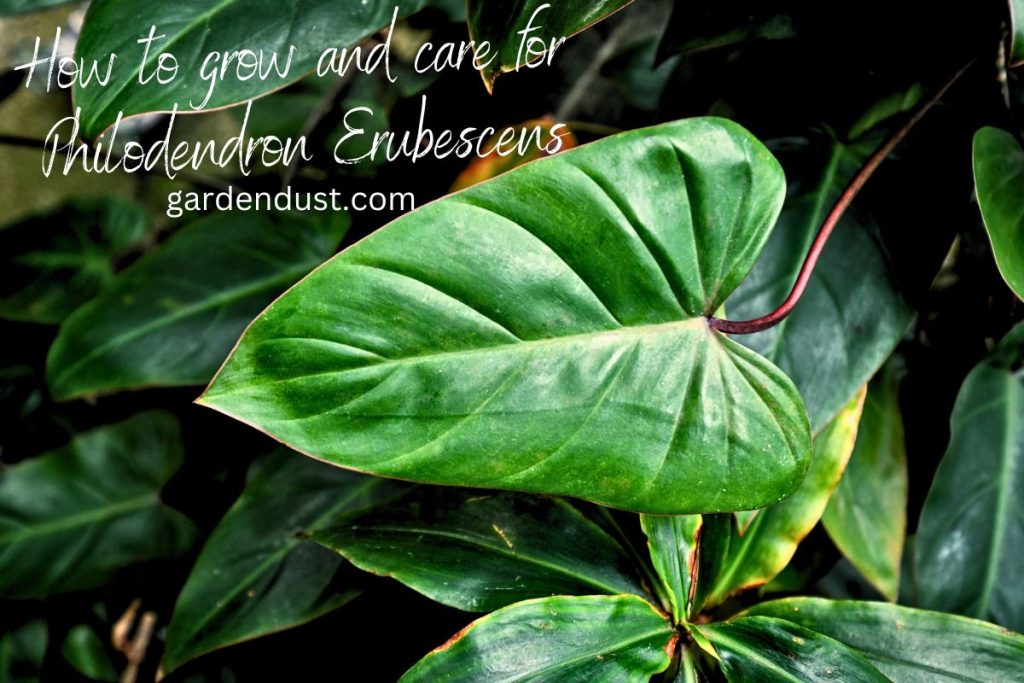Philodendron erubescens, also known as the Blushing Philodendron, is a popular houseplant among plant enthusiasts. It is a member of the Araceae family, which includes other popular indoor plants such as the Monstera and Peace Lily. This tropical plant is native to the rainforests of South America, particularly Brazil, and is loved for its stunning appearance and easy care requirements.
Description:-
Native – South America
Botanical Name – Philodendron erubescens
Common Name– Blushing Philodendron,Red-leaf Philodendron, Pink Princess Philodendron
The Philodendron erubescens plant has glossy green leaves that can grow up to 12 inches long and 6 inches wide. As the plant matures, the leaves turn a deep shade of burgundy, hence the name “Blushing Philodendron.” The leaves are heart-shaped with a pointed tip, and they grow on long, slender stems that can reach up to 3 feet in length. The plant can grow up to 4-6 feet tall and 2-3 feet wide, making it an ideal choice for larger spaces.
Care of Philodendron Erubescens
Philodendron erubescens, also known as Red-leaf Philodendron or Blushing Philodendron, is a tropical plant native to Colombia, Ecuador, and Peru. Here are some tips on how to care for this plant:
Lighting:
Philodendron erubescens prefers bright, indirect light. Too much direct sunlight can scorch the leaves, while too little light can cause the plant to grow slowly or lose its vibrant colors.
Watering:
Water your Philodendron erubescens thoroughly, but allow the soil to dry out slightly before watering again. Overwatering can lead to root rot, which is a common problem with this plant.
Humidity:
This plant prefers high humidity, so consider placing a humidifier near it or misting it regularly.
Soil:
Use well-draining soil that retains moisture but does not become waterlogged.
Fertilizer:
Fertilize your Philodendron erubescens once a month during the growing season (spring and summer) with a balanced, water-soluble fertilizer.
Temperature:
This plant prefers temperatures between 65-80°F (18-27°C). Keep it away from cold drafts and air conditioning units.
Pruning:
You can prune your Philodendron erubescens to control its size and shape. Remove any dead or yellowing leaves as needed.
Common Problem of Philodendron Erubescens
Philodendron erubescens is generally a hardy plant, but it can still experience some common problems. Here are a few issues you may encounter and how to address them:
- Root rot: Overwatering can lead to root rot, a common problem with Philodendron erubescens. If you notice the leaves turning yellow or the plant wilting, check the soil moisture and adjust your watering routine if necessary. You may need to repot the plant if the roots are damaged.
- Pests: Philodendron erubescens can be susceptible to pests such as spider mites, mealybugs, and scale insects. Inspect the plant regularly and treat any infestations promptly with insecticidal soap or neem oil.
- Brown or yellow leaves: Brown or yellow leaves can be a sign of overwatering, underwatering, or too much direct sunlight. Adjust your watering routine and move the plant to a location with less direct sunlight if necessary.
- Lack of growth: If your Philodendron erubescens is not growing as well as it should, it may need more nutrients. Try fertilizing it with a balanced, water-soluble fertilizer during the growing season (spring and summer).
- Drooping leaves: Drooping leaves can be a sign of underwatering or high temperatures. Check the soil moisture and water the plant if necessary. You may also want to move the plant to a cooler location if it’s getting too hot.
Types of Philodendron Erubescens
There are several different types of Philodendron erubescens, each with its own unique appearance. Here are some of the most common varieties:
- Philodendron erubescens “Red Emerald“: This is the most common type of Philodendron erubescens. It has deep green leaves with reddish-purple undersides.
- Philodendron erubescens “Pink Princess“: This variety has dark green leaves with pink variegation. It is a highly sought-after plant among collectors.
- Philodendron erubescens “Burgundy“: This type has deep red leaves that can appear almost black in low light.
- Philodendron erubescens “White Knight“: This variety has deep green leaves with white variegation, giving it a striking appearance.
- Philodendron erubescens “Black Cardinal”: This variety has dark green leaves with deep red undersides, making it a dramatic addition to any collection.
All of these varieties of Philodendron erubescens are relatively easy to care for and make great indoor plants. With their striking foliage and unique colors, they are sure to add a touch of tropical beauty to any space.
Propagation
Philodendron erubescens can be propagated through stem cuttings. Take a 6-8 inch cutting from the plant which has two leaves and a few nodes. Dip the cut end in rooting hormone and plant it in moist soil. Keep the soil moist and place the cutting in a bright indirect light until it develops roots. Once the roots have formed, the plant are ready to be transplanted to its permanent pot.
Benefits
With stunning appearance, plant has several health benefits. It helps to purify the air . It helps to improve humidity levels in the room, which can help alleviate dry skin, respiratory problems, and allergies.
This plant is a beautiful and easy-to-care that can add a touch of tropical elegance to any space with its glossy leaves and stunning burgundy color. Its low-maintenance and high-impact effect it become a favorite among plant lovers.
Is Philodendron Erubescens flowering ?

Yes, Philodendron erubescens is capable of producing small, inconspicuous flowers, but they are not usually the main attraction of the plant. The flowers are typically white or yellow and are borne on a spadix, which is a cylindrical spike-like structure that is surrounded by a leaf-like bract called a spathe. The flowers are followed by small, fleshy berries that are usually not edible. However, Philodendron erubescens is primarily grown for its attractive foliage rather than its flowers.






